Soil Test Report
Why Soil Testing is important before Construction?
It is important to check the quality of soil before you build your dream home. The ground where you are planning to make your dream home it is important to check the soil quality of it before your construction work begins.
Soil testing is primarily done to test the bearing capacity. The chemical and physical composition of the soil is checked during this process. The soil must have the ability to withstand the weight of the building. Quality of soil not only determines the bearing capacity but it ensures to determine the structure stabilization. Quality of Soil depends upon various factors such as weather, climate change and for the past years the land was deployed for what purpose and what was there previously.
The length and depth of the pillar determined during the foundation depending upon the quality of soil. The water level of the soil only can be determined from soil testing. Based on the soil testing reports quality of material can be decided. For example if due to moisture the area is prone to corrosion then it is important to choose only corrosion resistant TMT Bars for the construction.
Soil test is very important step of construction before it begins. If the soil testing is not done then the building will be exposed to unknown dangers and might the end result could be fatal.
Different types of Soil Testing for Construction
Gravity Test
Gravity of the soil is the ratio of unit weight of soil solids to that of the water.
There are quite a few methods by which the gravity test can be done but Density Bottle Method and Pycnometer Method is the most simple and common ones to get the accurate result. In Pycnometer method, Vertex specific gravity bottle is known as pycnometer it is weighed in 4 different cases that is
- Empty weight (M1)
- Empty + dry soil (M2)
- Empty + water + dry soil (M3)
- Pycnometer filled with water (M4)
At room temperature. From these 4 masses specific gravity is determined by below formula.
G = (M2 – M1) / (M2 – M1) – (M3 – M4)
Moisture Test
In this method samples are collected from the site and weighed before it is put on the oven before drying. After taking the weight it is out on the oven and dried at 110o + 5oC.
After 24 hours it is taken out from the oven and again weighed. The difference between two weights is noted and the water or moisture content is determined from the difference in weight.
Atterberg Limits Test
Atterberg limits test on soil is performed at 3 levels. The component for testing is done with fine grained soil and if any critical component from water is present then it can be determined with it. The three limits that are evaluated:
- Liquid Limit
- Plastic Limit
- Shrinkage Limit
* Liquid Limit Test
The device that is used for this test is called Casagrande’s liquid limit device. This device consist a cup with moving up and down mechanism. The cup is moved up and down with the help of handle the groove becomes closed at some point.
Once the water content of soil is determined procedure of if needs to be repeated 3 times post that a graph to be drawn between log N and water content of soil. Water content corresponding to N=25 is the liquid limit of soil.
* Plastic Limit Test
In this test small balls needs to be created by adding some water into it. After resting it for sometime the small balls are to put into glass plate and rolled it to 3mm diameter.
Until the threads break when it rolled into diameter that is less than 3mm water content is to be reduced. It is to determine the water content of resultant soil which value is nothing but plastic limit.
* Shrinkage Limit Test
The existing water in the soil is just sufficient to fill the voids. The below formula is used to be done for shrinkage test on soil.
Ws = (M2 – M1)n – (V1 – V2) Pw / M2
M1 = initial mass
V1= initial volume
M2= dry mass
V2= volume after drying
Pw = density of water
Dry Density Test
Dry Density Test in Soil is performed at 2 Levels
* Core Cutter Method
With the help of cylindrical core cutter of standard dimension is used to cut the soil from ground and the sample is tested by weighing it. Water content from that sample is determined and the dry density is calculated from the below relation.
P = (M/V) / 1+w
* Sand Replacement Method
In this method by excavation a hole is created and the soil dry density to be measured with it. The hole is filled with uniform sand of known dry density. Dividing the mass of sand poured into the hole with dry density of sand gives the volume of hole.
Proctor’s Compaction Test
Compaction in soil is one of the most important elements that are to find during Proctor’s Compaction Test on soil. It is to do the densification by reducing the air voids in soil. The level of Compaction is estimated as far as dry thickness of soil.
Types of Soil tests for building construction works depend on properties of soil. Design of the foundation is based on soil test report of construction site.
Soil tests for construction of buildings or any structure is the first step in construction planning to understand the suitability of soil for proposed construction work.
Soil which is responsible for allowing the stresses coming from the structure should be well tested to give excellent performance. If soil shouldn’t tested correctly then the whole building or structure is damaged or collapsed or leaned like leaning tower of Pisa. So, soil inspection or testing is the first step to proceed any construction.

Types of Soil Tests for Building Construction
Various tests on soil are conducted to decide the quality of soil for building construction. Some tests are conducted in laboratory and some are in the field. Here we will discuss about the importance of various soil tests for building construction. The tests on soil are as follows.
- Moisture content test
- Atterberg limits tests
- Specific gravity of soil
- Dry density of soil
- Compaction test (Proctor’s test)
Moisture Content Test on Soil
Moisture content or water content in soil is an important parameter for building construction. It is determined by several methods and they are
- Oven drying method
- Calcium carbide method
- Torsion balance method
- Pycnometer method
- Sand bath method
- Radiation method
- Alcohol method
Of all the above oven drying method is most common and accurate method. In this method the soil sample is taken and weighed and put it in oven and dried at 110o + 5oC. After 24 hours soil is taken out and weighed. The difference between the two weights is noted as weight of water or moisture content in the soil.
Specific gravity of soil
Specific gravity of soil is the ratio of the unit weight of soil solids to that of the water. It is determined by many methods and they are.
- Density bottle method
- Pycnometer method
- Gas jar method
- Shrinkage limit method
- Measuring flask method
Density bottle method and Pycnometer method are simple and common methods. In Pycnometer method, Pycnometer is weighed in 4 different cases that is empty weight (M1), empty + dry soil (M2), empty + water + dry soil (M3) and Pycnometer filled with water (M4) at room temperature. From these 4 masses specific gravity is determined by below formula.

Dry Density Test on Soil
The weight of soil particles in a given volume of sample is termed as dry density of soil. Dry density of soil depends upon void ratio and specific gravity of soil. Based on values of dry density soil is classified into dense, medium dense and loose categories.
Dry density of soil is calculated by core cutter method, sand replacement method and water-displacement method.
Core Cutter Method for Soil Dry Density Testing
In this methods a cylindrical core cutter of standard dimensions is used to cut the soil in the ground and lift the cutter up with soil sample. The taken out sample is weighed and noted. Finally water content for that sample is determined and dry density is calculated from the below relation.

In this method also, a hole is created in the ground by excavating soil whose dry density is to be find. The hole is filled with uniform sand of known dry density. So by dividing the mass of sand poured into the hole with dry density of sand gives the volume of hole. So we can calculate the soil dry density from above formula.
Atterberg Limits Test on Soil
To measure the critical water content of a fine grained soil, Atterberg provided 3 limits which exhibits the properties of fine grained soil at different conditions. The limits are liquid limit, plastic limit and shrinkage limit. These limits are calculated by individual tests as follows.
Liquid Limit Test on Soil
In this test, Casagrande’s liquid limit device is used which consist a cup with moving up and down mechanism. The cup is filled with soil sample and groove is created in the middle of cup with proper tool. When the cup is moved up and down with the help of handle the groove becomes closed at some point.
Note down the number of blows required to close the groove. After that water content of soil is determined. Repeat this procedure 3 times and draw a graph between log N and water content of soil. Water content corresponding to N=25 is the liquid limit of soil.
soil.
Plastic Limit Test on Soil
Take the soil sample and add some water to make it plastic enough to shape into small ball. Leave it for some time and after that put that ball in the glass plate and rolled it into threads of 3mm diameter.
If the threads do not break when we roll it to below 3mm diameter, then water content is more than the plastic limit. In that case reduce water content and repeat the same procedure until crumbling occurs at 3mm diameter. Finally find out the water content of resultant soil which value is nothing but plastic limit.
limit.
Shrinkage Limit Test on Soil
In case of shrinkage limit, the water content in the soil is just sufficient to fill the voids of soil. That is degree of saturation is of 100%. So, there is no change in volume of soil if we reduce the shrinkage limit. It is determined by the below formula for the given soil sample.

Where M1 = initial mass
V1= initial volume
M2= dry mass
V2= volume after drying
Pw = density of water.
Proctor’s Compaction Test on Soil
Proctor’s test is conducted to determine compaction characteristics of soil. Compaction of soil is nothing but reducing air voids in the soil by densification. The degree of Compaction is measured in terms of dry density of soil.
In Proctor’s Compaction Test, given soil sample sieved through 20mm and 4.75 mm sieves. Percentage passing 4.75mm and percentage retained on 4.75mm are mixed with certain proportions.
Add water to it and leave it in air tight container for 20hrs. Mix the soil and divide it into 6 – 8 parts. Position the mold and pour one part of soil into the mold as 3layers with 25 blows of ramming for each layer.
Remove the base plate and Weight the soil along with mold. Remove the soil from mold and take the small portion of soil sample at different layers and conduct water content test. from the values find out the dry density of soil and water content and draw a graph between them and note down the maximum dry density and optimum water content of the compacted soil sample at highest point on the curve.
FAQs
What are test conducted in soil before construction?
The important test conducted on soil before building construction are:
1. Moisture content test
2. Atterberg limits tests
3. Specific gravity of soil
4. Dry density of soil
5. Compaction test (Proctor’s test)
What is dry density of soil?
The weight of soil particles in a given volume of sample is termed as dry density of soil. Dry density of soil depends upon void ratio and specific gravity of soil. Based on values of dry density soil is classified into dense, medium dense and loose categories.
Dry density of soil is calculated by core cutter method, sand replacement method and water-displacement method.
How to determine moisture content of soil?
Moisture content or water content in soil is an important parameter for building construction. It is determined by several methods and they are:
1. Oven drying method
2. Calcium carbide method
3. Torsion balance method
4. Pycnometer method
5. Sand bath method
6. Radiation method
7. Alcohol method
Of all the above oven drying method is most common and accurate method. In this method the soil sample is taken and weighed and put it in oven and dried at 110o + 5oC. After 24 hours soil is taken out and weighed. The difference between the two weights is noted as weight of water or moisture content in the soil.
Soil tests required for deep foundations
While the composition and depth of the bearing layer for shallow foundations may vary from one site to another, most pile foundations in a locally encounter similar deposits. Since pile capacity based on soil parameters is not as reliable from load tests, as a first step it is essential to obtain full information on the type, size, length and capacity of piles (including details of load – settlement graph) generally adopted in the locality. Correlation of soil characteristics (from soil investigation reports) and corresponding load tests (from actual projects constructed) is essential to decide the type of soil tests to be performed and to make a reasonable recommendation for the type, size, length and capacity of piles since most formulae are empirical.
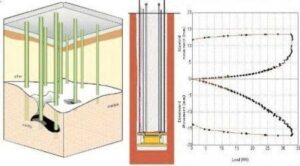
If information about piles in the locality are not available or reliable, it may be necessary to drive a test pile and correlate with soil data. Generally, the following tests may be required to obtain certain required data:
1. Direct shear test
It is conducted to estimated effective friction angle of cohesionless soil. Nonetheless, there are correlations which are developed to evaluate effective friction angle of cohesionless soil. for more information about shear strength test of soil click here.
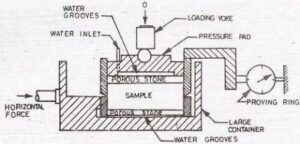
2. Standard penetration test (SPT)
It is performed to determine the cohesion (and consequently the adhesion) to determine the angle of friction (and consequently the angle of friction between soil and the pile and also the point of resistance) for each soil stratum of cohesion less soil of soil.
3. Static cone penetration test (CPT)
This test conducted to determine the cohesion (and subsequently the adhesion) for soft cohesive soils and to check with SPT result for fine to medium sands. Hence for strata encountering both cohesive and cohesion less soils, both SPT and CPT tests are required.
4. Vane shear test
it is used to estimated undrained in-situ shear strength of impervious clayey soils.
5. Undrained triaxial shear strength
It is carried out on undisturbed soil samples (obtained with thin walled tube samplers) to determine cohesion () and angle of internal friction () for clayey soils. Procedures for conducting this test is provided by ASTM D 2850-03, 2004. In case of driven piles proposed for stiff clays, it is necessary to check with the () and () from re-moulded samples. Drained shear strength parameters are also determined to represent in-situ condition of soil at end of construction phase. Details of this test procedure can be found in ASTM D4767-02, 2004.
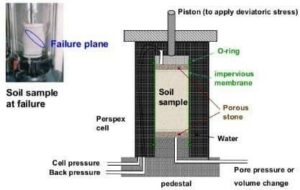
6. Pressure meter test
It is performed to determine the stress- strain curve of horizontal loading. The equipment is either inserted into pre-drilled borehole or a self-boring pressure meter is used. Unless the soil is isotropic, the same value cannot be adopted for the vertical direction. This test is performed specifically for piles that subjected to lateral loading.
7. Ground water condition and permeability of soil
Ground water condition and soil permeability influence the choice of pile type to be recommended. Hence the level at which water in the bore hole remains are noted in the bore logs. Since permeability of clay is very low, it takes several days for water in the drill hole to rise upto ground water table. Ground water samples need to be tested to consider the possible chemical effects on concrete and the reinforcement. Result of the cone penetration test for the same soil show substantial scatter. Hence, they need to be checked with supplementary information from other exploration methods.
Soil Tests for Shallow and Raft Foundations
Soil tests required to determine safe bearing capacity of shallow foundations and raft foundations are discussed here. These tests are as per IS 6403 – 1981. Apart from ascertaining the highest level ever reached by the groundwater table and tests for classification of soil as per IS 1498 – 1970 based on grain size analysis as per IS 2720 (Part –IV)– 1985, index properties of soil as per IS 2720 (Part-V) – 1985, the following tests are required to determine safe bearing capacity based on shear strength consideration: 1. Standard penetration test as per IS 2131 – 1991 for coarse grained / fine grained cohesionless soils with semi-pervious clayey soils (i.e. soils with clay upto 30%). 2. Direct shear test (controlled strain) as per IS 2720 (Part – 13) – 1986. Consolidated undrained tests for cohesive and for soils and consolidated drained tests for cohesion less soils. The results may be compared with standard penetration test / static cone penetration test results. Since there is escape of pore water during box shear, partial drainage vitiates the consolidated undrained test. Hence this test is not exact for semi-pervious soils such as clayey sands / silts (i.e. with clay more than 15% but less than 30%). For such soils, triaxial tests are required if shear strength is critical criterion. 3. Static cone penetration test as per IS 4968 (Part -3) – 1976 for foundations on non-stiff clayey soils such as fine grained soils (i.e. more than 50% passing through 75 micron sieve). In fine and medium coarse sands such tests are done for correlation with standard penetration test and to indicate soil profiles at intermediate points.

- Unconfined compressive strength test as per IS 2720 (Part-10) – 1973 for highly cohesive clays except soft / sensitive clays. 5. Vane shear testsfor impervious clayey soils except stiff or fissured clays. 6. Triaxial shear tests for predominantly cohesive soils. If shear strength is likely to be critical.
Soil Tests for Shallow Foundations
Tests required to determine allowable bearing pressure for shallow foundations on settlement consideration: 1. Standard penetration test as stated above. 2. Consolidation test as per IS 2720 (Part-15) if the settlement of clayey layer /layers calculated on the basis of liquid limit and in-situ void ratio indicates that settlement may be critical. Consolidation test is not required if the superimposed load on foundation soil is likely to be less than pre-consolidation pressure (assessed from liquidity index and sensitivity or from un-confined compressive strength and plasticity index). 3. Plate load tests as per IS 1888 – 1982 for cohesionless soils and soils where neither standard penetration test or consolidation test is appropriate such as for fissured clay / rock, clay with boulders etc..
Soil Tests Required for Raft Foundations
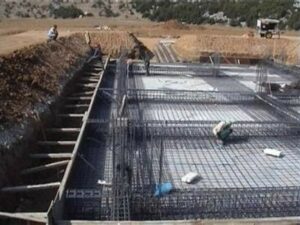
Apart from other tests for shallow foundations, the following soil tests are required especially for raft foundations: 1. Static cone penetration test as per IS 4968 (Part-3) – 1976 for cohesionless soils to determine modulus of elasticity as per IS 1888 – 1982. 2. Standard penetration test as per IS 2131 – 1981 for cohesionless soils and soils to determine modulus of sub-grade reaction. 3. Unconfined compressive strength test as per 2720 (Part -10) – 1973 for saturated but no pre-consolidated cohesive soil to determine modulus of sub-grade reaction. 4. As specified in IS 2950 (Part -1) – 1981¸ plate load test as per IS 1888 – 1982 where tests at Sl. No. – 1 to 3 above are not appropriate such as for fissured clays / clay boulders. 5. In case of deep basements in pervious soils, permeability is determined from pumping test. This is required to analyze stability of deep excavation and to design appropriate dewatering system.
Why Soil Testing is Important before Construction?
When you decide to construct a house, soil testing is one of the first things to be done after buying a plot of land.
Soil testing is the first step in construction planning to ensure whether the plot of land is suitable for constructing any structure to avoid dreadful phenomena in future like The leaning Tower of Pisa.
The type of tests on soil reveals the physical and engineering properties of soil that help to determine the type of foundation to be laid for construction. Knowing moisture content, mineral presence, density, permeability and bearing capacity of the soil gives an idea of working considerations for foundations and earthworks. Like higher sulphur content in the soil requires cement that provides resistance to sulphur such as Sulphate-resisting Portland Cement (SRPC).
Role of Soil Testing in Foundations
Foundation is the first and important step of construction, a small defect or damage can fail or collapse the whole building. Foundation acts as a guardian to the building and protects it from any physical forces emerges in the subsoil. It helps to sustain and maintain the load bearings from the building to the ground.
The soil should consist of all physical and chemical properties to withstand the weight of the building. The soil testing and analysis helps to determine the rate of settlement and bearing capacity of the soil. These tests also help to define the length and depth of the pillars to lay the foundation.
The water content in the soil can only be known by soil testing, which helps to settle the level of humidity within the foundation. It’s necessary to have a note about soil movements, the way soil reacts in the presence and absence of water. Generally, soil movement is higher in clay soil than sandy soil.
Removal of vegetation also plays a very important role, presence of weeds, roots of old cut trees can cause soil movement in the land. These all factors affect the foundation settlement posing a threat to the structure.
Types of Soil Testing
If soil is not tested properly, it develops cracks in future and collapse in due course of time. Various types of tests are executed to know the surface characteristics of soil, and some of them are briefly explained below:
Moisture Content Test
This test is used to determine the moisture and water content in the soil. Various methods like Calcium Carbide Method, Oven Drying Method, Sand bath Method, Radiation Method, and Alcohol Method
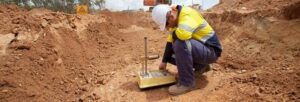
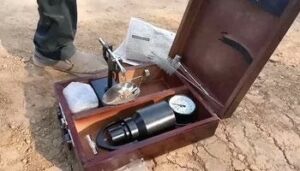
Of all the methods, Oven Drying method results are most accurate in which the moisture content is defined as the mass of water that can be removed from the soil by heating at 105 – 110°C.
The water table level is only known from soil testing, which helps to find the level of humidity in the foundation.
Specific Gravity Test
This test provides information about the degree of saturation of the soil and void ratio. The void ratio is defined as a ratio of void volume to the volume of the solids present in the soil.
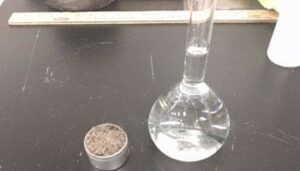
The standard specific gravity of soil ideal for construction should be from 2.65 to 2.85. The soil should consist of the low-value presence of organic content, porous matter and heavy materials.
Dry Density Test
Density test helps to classify the soil into three types – loose, medium and dense, with the weight of the soil samples. The lesser the density, the stronger the foundation.

It can be tested by using sand replacement method, core cutter method and water-displacement method.
Atterberg Limits Test
It is used to measure the critical water content of the soil. There are plastic limits, liquid limit and shrinkage limit, which displays the attributes of fine-grained soil at different conditions.
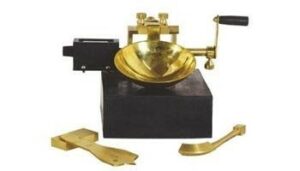
Compaction Test
The most commonly used compaction test is Proctor’s test, determines the compaction characteristics of soil reducing air voids by densification. This test gives information about maximum dry density and optimum water content of compacted soil.

These are some of the frequently used soil tests for any structure. Most suitable construction techniques for any building can be achieved by soil testing, as it is the first step, to begin with. It is recommended to perform them without any fail to avoid damages and sinking of building in the future.

